#salon holofernes
Text

Mrs. Charles E. Inches (Louise Pomeroy), 1887
Oil on canvas
Married to a Boston physician, society hostess Louise Inches was known for her beauty.
Sargent, on his first working trip to the U.S., offered European sophistication to his clients, here summoning the elegant look of 18th-century French portraits. Critics commented on the painter's modernity, but also recognized historical connections; a Boston writer called Mrs. Inches "one of the most brilliant pieces of coloring that has been painted since the days of Titian." Just as at the Paris Salon, visitors to Sargent's 1888 exhibition in Boston were "like a conclave of ghouls at a banquet of human fiesh, tearing and rending the feast before them," according to one reporter. They compared Sargent's depictions with the people they knew. "Between those who thought them too beautiful and those who thought them not beautiful enough, all just speculation of method and execution was lost. It might have been a Jarley's wax works or Mme. Tussaud's exhibition." Others, in private, were less discreet: "I think Mrs. Inches looks as if she would bring you the head of Holofernes for the asking." wrote Fanny Lang to Isabella Stewart Gardner.
8 notes
·
View notes
Photo
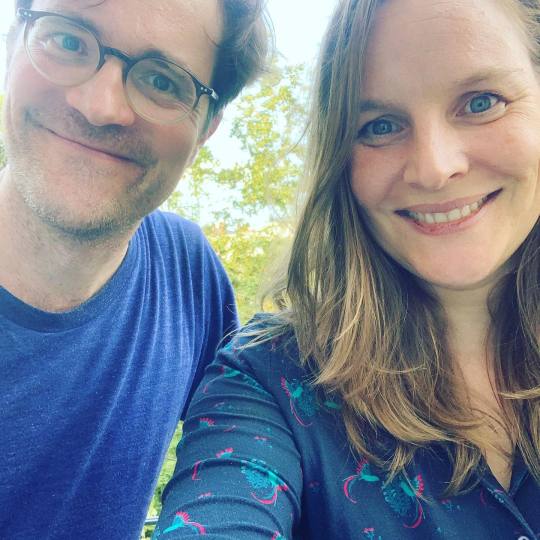
2 notes
·
View notes
Photo
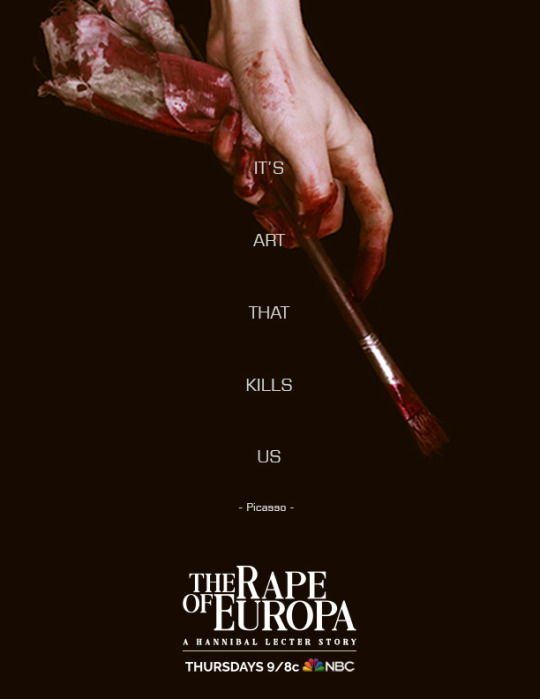
@random-emerald-thoughts as promised, here are the details on season 3 of The Rape of Europa Hannibal AU television series.
If anyone is seeing this for the first time and needs to know what the heck this is, links are here:
OVERVIEW
SEASON 1 SUMMARY | SEASON 1 DETAILS
SEASON 2 SUMMARY | SEASON 2 DETAILS
SEASON 3 SUMMARY | SEASON 3 DETAILS
SEASON 4 SUMMARY | SEASON 4 DETAILS
Below the cut is the following information:
Additional Information about each episode and the real crimes that inspired some of the stories
Artwork featured in each episode
A couple pieces of Fan Art that didn’t make the cut for the Season Summaries.
Flashbacks featured in each episode
General Season Arcs / Information / Themes
General Clannibal info (Will they, won’t they? Spoilers - they totally do.)
Season 3 General Notes / Arcs / Themes:
The third season follows the first half of the novel Hannibal fairly closely as far as Dr.Fell and Rinaldo Pazzi are concerned.
Clarice’s Art Team and Jack Crawford’s team with Behavioral Science team up to work together. Jack Crawford, who occasionally showed up in episodes here and there in the first couple of seasons takes on a more prominent role in this season.
While we’ve seen a few flashbacks to the events of The Silence of the Lambs, the first two season’s flashbacks were much more heavily based on Hannibal Rising, so we will start to see a lot more SOTL this season.
The season draws heavy influence from the murders of Il Monstro. The viewer, for many episodes, will not quite be sure if Hannibal Lecter is Il Monstro or not. He will claim not to be, but scenes are set up to show that he could possibly be the killer.
The season also takes much from the Pazzi Conspiracy of 1478, just as the novel does.
After Johnny and Clarice hooked up in the second season episode Whoso List to Hunt, they are tentatively seeing one another. Clarice is uncomfortable with this, and Johnny likely feels they are on stronger footing than Clarice does. She does not put a label on it but has accepted that he is in love with her. They do not talk about it in front of other people, but everyone sort of ‘knows.’
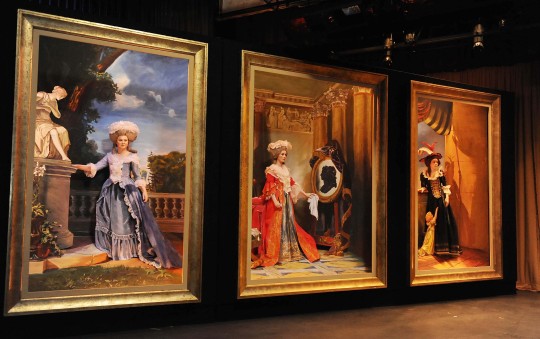
SEASON 3, EPISODE 1: Tableaux de la Mort
DATE: August 1992
FLASHBACKS:
Jack Crawford - A man shouts at Phyllis and calls her "Bella." while they are in Florence
Clarice - Clarice remembers her first meeting with Jack Crawford, who tells her about Buffalo Bill
Jack Crawford - Jack goes home to his dying wife
Pazzi - Pazzi works on the Il Monstro case. He holds a photo of a victim in hand.
Pazzi - Pazzi walks home, sees a poster of Primavera outside the Uffizi. He goes inside and stands in front of it and makes a connection about Il Monstro.
ARTWORK FEATURED:
The Last Supper by Leonardo Da Vinci, done as the last Tableaux Vivant at Pageant of the Masters in Laguna Beach, California.
Primavera by Sandro Botticelli - Uffizi Gallery
NOTES:
This episode - and really the entire season is heavily inspired by the real Il Monstro case in Florence.
The season opens with Clarice Starling attending the Pageant of the Masters in Laguna Beach, California. She has begun to seek out art and culture on her own outside of work.
The Pageant of the Masters is a yearly Tableaux Vivant Festival, and it is an absolutely magical evening, and if anyone reading this has not attended, I HIGHLY recommend. It does not disappoint.
The Title Tableaux de la Mort is a play on the Tableaux vivant. The word “Tableau Vivant” literally means “Living Picture” while Il Monstro’s tableaux depict a picture - but using dead bodies.
We witness the staging of the traditional last painting performed as a Tableau - Da Vinci’s Last Supper. We hear the voiceover telling us about the painting - this year the narrator (for the festival) gives a beautiful discussion on transubstantiation, about the drinking of blood and eating of the flesh.
It should be noted that after catching (who he believed was) Il Monstro the first time, Pazzi went on to train at Quantico, just like in the novel. He began his training just as Clarice had caught Buffalo Bill and graduated. He had looked over the case file and remembers admiring her work. For this reason, he “Knows of” Clarice Starling.
Pazzi knows Crawford and Johnny personally from his time training at Quantico. Having caught Il Monstro, he spent much time with Crawford at Behavioral Science discussing the case. Johnny and Pazzi also got along well.
The Italian Police are understaffed and overworked. In 1992 and 1993, they were extremely busy dealing with the Corleonesi Mafia Clan. Pazzi has recently been disgraced when Il Monstro began killing again, signifying that he got the wrong man. His failure weighs heavily on him, and he knows he’s basically being put out to pasture. He is still employed, but not considered for any large cases. Because of all of this, the Italians reach out the Americans - specifically to Jack Crawford at Behavioral Science and ask if they can borrow a small team.
Jack Crawford agrees to give a few people from his team, but also suggest Clarice and her team for the case as well. Since the case is art-related, he feels that Clarice may lend a different view to things than a normal agent hunting a serial killer. Secondarily, Jack Crawford feels that the killer may actually be Hannibal Lecter. Lecter is known for his whimsy. Because Clarice is familiar with the Lecter case, he feels this is another excellent reason to bring her team in to work along Behavioral Science and the Italian Police.
Clarice is excited to be working with Behavioral Science, even if it is overseas and not officially as a member of Behavioral Science. She hopes that if she proves herself on this case that she will be able to get the promotion that she craves.
Lecter is spoken of in this episode but is not seen. Last we left him he had escaped in Sardinia after making sure Clarice and Margot were safe.
SEASON 3, EPISODE 2: La Vita Nuova
DATE: September 1992
FLASHBACKS:
Pazzi - Pazzi trains at Quantico.
Pazzi - Pazzi meets Crawford and Johnny.
Pazzi - Pazzi attends a party on the Chesapeake with his wife
Clarice - Clarice remembers her first meeting with Lecter. When she leaves, Miggs throws semen in her face, which upsets Lecter.
Clarice - Hannibal tells Clarice to look in the car of Benjamin Raspail for a Valentine
Clarice - Clarice finds Klaus's head
ARTWORK FEATURED:
Palazzo Vecchio - Salon of Lilies, Florence
Bronze Statue of Judith and Holofernes by Donatello, Salon of Lillies
Dante’s first sonnet from La Vita Nuova by Dante Alighieri
NOTES:
The title is the name of a piece of work by Dante about courtly love. It is believed to have been about Beatrice Portinari, Dante’s lifetime love.
The Curator of the Capponi Library is missing, and Rinaldo Pazzi has been placed onto the case. It is not terribly important, and no one is particularly worked up over the curator’s disappearance. He goes to the Salon of Lilies where he speaks to the Directors of the Uffizi and the Belle-Arti Commission. Both boards are busy speaking to Dr.Fell and do not have much time to speak to Pazzi.
Pazzi, having gone over Lecter’s forms before meeting (we are shown Pazzi looking over Dr.Fell’s paperwork) doesn’t immediately see Dr.Fell. Suddenly his voice appears - he is faced away from the viewer. He stands next to a bronze of Judith and Holofernes, and for a moment it seems as if the statue is speaking.
Dr.Fell gives a lovely debate as to why he feels he should be allowed to keep the position of Curator of the Capponi Library. He reads from Dante’s La Vita Nuova, and everyone is impressed. They agree that he should lecture to the Studiolo in several months' time, at which point they will determine if he gets the keep the position permanently.
Dr.Fell reads the following Sonnet, which will (hopefully) properly foreshadow what will happen with our two lovers throughout the season.
To every loving, gentle-hearted friend,
to whom the present rhyme is soon to go
so that I may their written answer know,
greetings in Love’s own name, their lord, I send.
The third hour of the time was near at end
when every star in heaven is aglow
‘twas then Love came before me, dreadful so
that my remembrance is with horror rent.
Joyous appeared he in his hand to keep
my very heart, and, lying on his breast,
my lady, veil-enwrapped and full asleep.
But he awakened her, and of my heart
aflame, he humbly made her, fearful, taste:
I saw him, finally, in tears depart.
After the debate, Pazzi speaks privately with Dr.Fell. He asks about a scar on his hand. He then begins to speak about the previous Curator. “You know, I am sure, that the previous Curator has mysteriously disappeared.” “I am aware.” Hannibal Lecter says, and we flash to a quick shot of Lecter slitting the old Curator’s throat. “And the man has left no notes that you have found?” Another flash quickly shows us the Curator’s body dropped to the bottom of the Arno river, his feet in a block of cement. “No, I’m afraid he left no note that anyone has been able to find,” Lecter says. Pazzi asks if he can come by to the curator’s belongings and Dr.Fell agrees. Then he asks Pazzi if he is a Pazzi of the infamous Pazzi’s as his visage looks like a painting at the Pazzi family chapel. Pazzi asks if he may come by to pick up the Curator’s belongings, and also says that several other team members from America might also have to ask him a few questions - he apologizes for any duplication of effort. Dr.Fell says he understands and questions why the American police would be in Florence. Pazzi admits it is actually the F.B.I. - Behavioral Science and a couple of other people from another division of the F.B.I. - Clarice Starling, an agent who caught the serial killer Buffalo Bill is in Florence helping the Italian Police.
We are shown many flashbacks of Pazzi’s time in America at Quantico throughout this episode.
Clarice also remembers her first meeting with Hannibal Lecter and the beginnings of the Buffalo Bill Case. She thinks about the Buffalo Bill case in conjunction with the Il Monstro case, as well as her information on the Lecter case.
At home, Dr.Lecter finds a photo of Clarice Starling in the paper. The article discusses the Getty kidnapping.
Il Monstro strikes again - this time killing two people, and placing them in a tableau representing Judith and Holofernes. The last time we’ve seen Judith and Holofernes was in the Salon of Lillies where we were unsure if it was the Statue or Dr.Fell speaking...this will link Lecter and Il Monstro in our minds. Is Jack Crawford right? Is Hannibal Lecter Il Monstro?
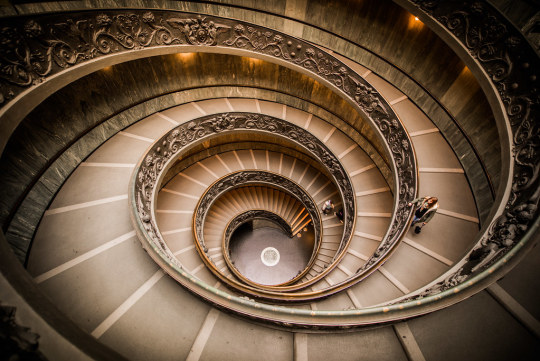
SEASON 3, EPISODE 3: The Monuments Men
DATE: October 1992
FLASHBACKS:
Clarice - Clarice performs an autopsy on Kimberly Egan
Clarice - Clarice visits the Smithsonian about a moth
Hannibal - Hannibal tells Clarice about the significance of the moth in exchange for personal information. They talk about transformation. She says the worst memory of childhood was the death of her father.
Hannibal - Hannibal agrees to help Clarice Starling Catch Buffalo Bill in exchange for privileges
ARTWORK FEATURED:
The Ecstacy of St.Theresa by Bernini
Bramante Staircase by Giuseppe Momo
Portrait of a Young Man by Raphael
The Leaning Tower of Pisa by unknown, likely Diotisalvi)
Excerpts from Dante’s La Vita Nuova and The Divine Comedy by Dante
NOTES:
One of the inspirations for this episode is the 2009 story of a woman who found an original Jasper Johns painting in Portabello road. In our case, however, the painting found is Raphael’s Portrait of the Young Man, which has been missing since WWII and is still widely believed to exist.
Another big influence for this episode is honestly the novel Angels and Demons, which I read long before the novel Da Vinci’s code came out. I was in art an art history class at the time, and so my friend and I read the novel together, solving each art history crime along with the character and it was a really great time. I figured one episode with puzzles about artwork and a sort of “race” to find something might be fun.
As Ardelia is dealing with the painting and its three claimants, the various clues Clarice is following around Italy sort of tell her more and more about the war. We learn about the Monuments Men and their quest to protect artwork from being destroyed.
Hannibal Lecter - who Clarice has not yet seen and does not yet know is residing in Florence - sends Clarice on a hunt around Italy with various poems and clues keyed to pieces of art. Often his poetry is keyed to Dante.
You must depart from Florence
This is willed already, sought for, soon to be
accomplished by the one who plans and plots
where - every day - Christ is sold and bought
You shall leave everything you love most dearly
this is the arrow that the bow of exile
shoots first. You are to know the bitter taste
of others bread, how salt it is, and know
how hard a path it is for one who goes
descending and ascending others staircase
- Paradiso, Dante
There is a clue about a double helix, which winds up being the Bernini staircase. There is another clue about somewhere she can walk down but go up, which of course means the leaning tower of Pisa. The tower would have been closed to the public at this time (it was re-opened in 2001), but as an Agent would have been able to go up.
Many of the clues have to do with Dante and Paradise, as well as about transformation.
As Clarice journeys around Florence, she remembers her first time meeting Hannibal Lecter and starting to work on the Buffalo Bill Case. She remembers him agreeing to help her.
Finally, she meets Lecter at Santa Maria della Vittoria, where they stand before Bernini’s sculpture The Ecstacy of St.Theresa. He tells her he knows why she is here, and that he knows Jack believes he is the one who is guilty of the crimes. He promises to help her catch Il Monstro in order to prove his own innocence and stay away from the police. She asks him why she should agree to anything - the last agreement they made - that he would not kill Pierre Trebelaux, ended in him breaking that agreement. He asks her about Johnny. The theme of the statue before them is not lost on either of them, and Clarice is uneasy. Finally, he tells her she doesn’t have much of a choice - he gave her information to find a killer once before, and he can do so again. She finally agrees.
Eventually, Ardelia negotiates a truce and all three claimants are allowed joint ownership on the condition that they allow the painting to reside in a museum. The last shot of the episode shows it hanging in the Uffizi.
October 31 – Pope John Paul II issues an apology and lifts the edict of the Inquisition against Galileo Galilei. Hannibal Lecter would likely mention this in one of his clues.
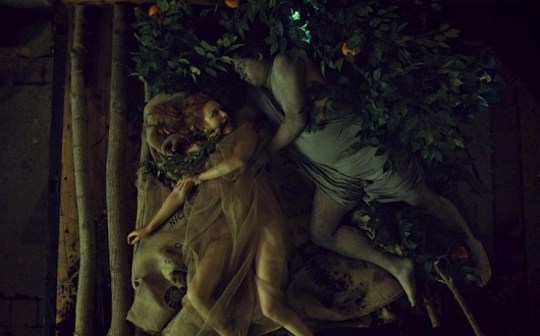
SEASON 3, EPISODE 4: The Lost Wax Process
DATE: October 1992
ARTWORK FEATURED:
The Card Players by Paul Cezanne
Juggling Man, by Adriaen de Vries
NOTES:
This episode is heavily influenced by several cases in which people have faked thefts, or intentionally destroyed their art in order to collect insurance payments.
A wealthy businessman who everyone believes is successful is secretly going bankrupt. He has a wonderful private art collection, and he hires someone to steal it from him. When investigating the claims, the insurance company becomes suspicious and turns the case over to the F.B.I. Ardelia, with her legal background, is sent in to pose undercover as an insurance claims adjuster to uncover the truth.
Il Monstro kills again, but this time he doesn’t kill in Florence, but instead in Rome.
The title references the method of metal casting in which molten metal is poured into a mold that has been created with a wax model and the wax model is melted and drained away.
The victim of Il Monstro makes a mold of the victim and made duplicates – the body is never found.
This episode features Ardelia almost exclusively. While Clarice appears at the end when the victim of Il Monstro is discovered, Ardelia carries this episode.
SEASON 3, EPISODE 5: The Pazzi Conspiracy
DATE: November 1992
FLASHBACKS:
Clarice - Hannibal tells Clarice the Hospitals to research and what to look for - what Billy's trees will look like, what the profile she is looking for is.
Pazzi - Pazzi remembers his time at Quantico and looks over the photos of Hannibal Lecter’s cell. He remembers seeing Lecter’s sketch of the Duomo from the Belvedere.
ARTWORK FEATURED:
Clarice Orsini - Domenico Ghirlandaio
Francesco de’ Pazzi as St.John the Baptist, Basilica di Santa Croce by Luca della Robbia
Hanged Pazzi Sketch - Leonardo Da Vinci
NOTES:
This episode is heavily influenced by the Pazzi Conspiracy of 1475, which took place on Easter Sunday.
After a meeting with Dr.Fell, Pazzi walks up to the battlements of the Belvedere and looks out at the view. He watches Dr.Fell walk away down on the street. He looks at the view again and realizes he’s seen a sketch of this very view. He flashes back to his time at Quantico when he was allowed to look over the Lecter files. He remembers seeing this sketch in Hannibal Lecter’s cell. He realizes Dr.Fell is Hannibal Lecter. What’s more - he believes Dr.Lecter is Il Monstro.
Pazzi notices the reward poster for Hannibal Lecter and calls the phone number. The poster does not specify who is offering the reward, but it is clear that is not the F.B.I. If Pazzi chooses to take down Lecter, he will be doing so as a bounty hunter, not as a police officer.
Pazzi is told that in order to get the money he must prove that Lecter is indeed where he is stated to be. The evidence must be in the form of a fingerprint. Pazzi realizes he must somehow figure out how to get Dr.Fell’s fingerprints in order to get the money.
Clarice speaks to Pazzi about the Il Monstro case, but Pazzi has become difficult. Since Pazzi believes that Hannibal Lecter is also Il Monstro, he no longer wants Clarice to catch Il Monstro. If he, Pazzi, can catch Il Monstro, he would have not truly failed. He becomes disinterested and uncooperative with Clarice and her questions.
Clarice and Hannibal talk about Pazzi and Lecter realizes (but does not say anything) that perhaps Pazzi is on to him. He wonders if Pazzi will rat him out. Lecter then tells Clarice a bit more of Florentine history. They talk about the Duomo, and Clarice says it’s her first memory of him - telling her about it. He tells her more - about the building of the dome in a time before they understood how to complete it. As they walk inside he tells her about the Pazzi conspiracy that took place in 1478 on Easter Sunday. She asks if Pazzi is any relation, and he says that yes, he is. There is a likeness of him in his family’s chapel - he will show her some time. He goes on about the conspiracy, about how at the elevation of the host on Easter Sunday that Francesco de’ Pazzi tried to kill Lorenzo de Medici. Instead, Pazzi wound up stabbing himself in the leg and was ultimately hanged for his crimes. He shows her a painting of Lorenzo and she asks who the woman beside him is - he tells her it is Lorenzo’s wife, Clarice. (True, look it up)
Clarice and Lecter talk about art and Il Monstro. He notes he is clearly an artist with some skill. Clarice decides to ask art schools in Italy for lists of problem students or students who had been expelled. It’s a big list, and the Art Crime Team and Behavioral Science team members will each be given a handful of people to investigate over the next few episodes, keeping them busy.

SEASON 3, EPISODE 6: Effets de soir
DATE: December 1992
FLASHBACKS:
Clarice - Lecter sketches Clarice's face on a clock and asks him about a transfer. She tells him about going to Montana. Chilton listens in.
Hannibal - Hannibal and Senator Martin negotiate. Hannibal gives Senator Martin the name Billy Ruben to mislead her.
ARTWORK FEATURED:
L'honestà negli amori by Alessandro Scarlatti
NOTES:
Dr.Fell attends the symphony. As do Clarice and Johnny and Laura and Rinaldo Pazzi. They all chat together. Johnny still is not a fan of Dr.Fell and Pazzi is wary of having Dr.Fell in front of his wife. He is further concerned when Dr.Fell flirts shamelessly with Laura. What’s more, Laura flirts right back and is charmed. Pazzi watches on, horrified. Clarice, jealous, cannot say anything.
Dr.Fell gives Laura the Scarlatti libretto with his notes on the original. She is intrigued and delighted. Again, Clarice is miffed and sulks for the rest of the performance, which annoys Johnny.
Pazzi has hired a man by the name of Gnocco to get Dr.Fell’s fingerprints. He purchases a silver bracelet, highly polished. He tells Gnocco that he wants him to pick Dr.Fell’s pocket, but to botch the job in the hopes that Dr.Fell will get his fingerprints on the bracelet.
After several days of watching Dr.Fell, Gnocco finally goes in. Dr.Fell grabs him and stabs him. Pazzi, knowing he will be responsible for Gnocco’s death, pulls him into an alcove and lets him bleed out. He then leaves him there to be found by the police.
Pazzi looks over the bracelet, but it is covered in blood and he does not think that he can get any workable fingerprints off of it. He goes home angry and upset.
Laura tries her best to make her upset husband happy, but it is clear that she is unhappy in her marriage. She asks him if he will please return Dr.Fell’s libretto to him. Pazzi mumbles for her to put it on his desk and he will take it back in a few days. As he gets up to go to bed, he passes his desk and sees the libretto. He looks into his bedroom where his wife is asleep. At first he is jealous, thinking of Dr.Fell charming his wife...but then he realizes Dr.Fell’s fingerprints might be on the document.
Pazzi sends away the Libretto to be analyzed in the hope that the prints are a match.
Il Monstro strikes again - this time killing a current member of the Accademia Belle Arti, one of the boards that, as curator, Dr.Fellmust work alongside. Clarice wonders if Hannibal Lecter, in an attempt to better his chances of keeping his job as curator, may actually be Il Monstro. And if he is, is he misleading her with other information?
SEASON 3, EPISODE 7: First Principles
DATE: December 1992
FLASHBACKS:
Clarice – Clarice discussed first principles with Hannibal Lecter
ARTWORK FEATURED:
Venus of Urbino by Titian
The Sacrifice of Isaac by Caravaggio
Cache of Lesser works, numerous small sketches, and small bronzes
NOTES:
This episode is inspired by several instances in which museums tend to not report thefts of paintings because it will cause problems with insurance, as well as alert the media to various flaws in their security, which could cause further theft.
Clarice’s team receives a tip from an anonymous Museum worker about a cache of paintings in a warehouse. They obtain a warrant and uncover a small group of paintings that have been stolen from museums around Italy. But Strangely, none of the paintings have been reported missing.
Clarice’s first thought is that since none of the pieces have been reported missing, they may perhaps have been forged. She calls the museums and is told that each painting is still in the collection, but a few museums admit that their pieces are under restoration. Clarice is concerned perhaps the pieces were stolen during restoration, or perhaps that the pieces in the warehouse are forgeries.
They go to the warehouse together and it is confirmed that all of the paintings are authentic.
Clarice then begins the tasks of going to each museum again. Most of the curators are shocked to find their paintings missing from storage/conservation area, but one curator is a bit cagey. Clarice thinks perhaps he may hold a bit more information.
Eventually, it is uncovered that due to financial problems and looking at these expensive paintings day after day, the curator worked with docents in other museums to forge an agreement for people to look the other way, enabling the curator to amass a small collection of art that he could sell to the Mafia in order to pay his bills.
Clarice, still going through lists of problem students and expulsions from various schools, wonders if they may be holding back information, as they have led her nowhere.
SEASON 3, EPISODE 8: Finishing the Arch
DATE: January 1993
FLASHBACKS:
Clarice - Dr.Lecter tells Clarice to look for rejections from several hospitals for her candidates for Buffalo Bill.
ARTWORK FEATURED:
The Baldin Collection with works by Dürer, van Gogh, Manet, Rembrandt, Rubens, Titian
NOTES:
This episode is inspired by the real-life Baldin Collection, a collection of 364 masterpieces taken from Germany to the Soviet Union by Soviet Army officer Victor Baldin during the end of WWII. The paintings came from a cache of pieces stored in Brandeburg castle to protect them from air raids. The pieces Baldin took were hidden for a year, but in 1991 the collection was moved to the Hermitage and the existence of the collection was declassified and revealed to the world in 1992. It remains there to this day…but at the time, there was a great deal of discussion (there certainly still is a discussion) about what should be done. The works were stolen…but they were also saved from destruction. And, do Baldin’s credit, he did appeal to soviet leaders to return them to Germany, proving that he really did take them only for their protection. Boris Yeltsin agreed to return the works, but subsequent Russian governments overturned the confirmation.
Our story takes place in the midst of that Government discussion. Should paintings be returned to Germany or stay in Russia? If returned to Germany, should they be put into a museum, or should the individuals who owned the paintings get them? How should it be handled politically, monetarily, etc?
Clarice and Ardelia look over the collection and assess the situation – what pieces belong to people, and what pieces would be harder to find their owner (owners being dead). They go to the Russian Government, where there is much back and forth.
Eventually, Clarice and Ardelia go to speak with Victor Baldin and he tells them about taking the paintings and his motivations. They get to talking about paintings and the war and Hitler. Baldin remarks about Hitler loving art and wanting to be an artist. He wonders if perhaps Hitler had not been rejected from art school if instead of becoming Chancellor and bringing war, he might instead have been sitting in a field painting.
This gets Clarice thinking. She begins to think about her past cases, murderers and rejection from society, etc, She realizes suddenly that Il Monstro is clearly an artist…he has the skill, but no major issues have been noted with most students. No major behavioral issues she can link to all the murders. Clarice realizes suddenly he wasn’t a student – that he was rejected from an art school and that he is picking off, one by one those that rejected his application. She heads back to Europe before Il Monstro kills again.
January 15, 1993, Toto Riina, a fugitive of the Mafia is finally arrested after 23 years. Over the upcoming year, the Mafia will begin to retaliate with a series of terrorist attacks. This would be on the news as well as be something that the Italian police are busy with. It is also important to note in this episode, as it ties in with the Uffizi bombing later in the season.
SEASON 3, EPISODE 9: The Museum of Atrocities
DATE: February 1993
FLASHBACKS:
Crawford - Crawford is harassed by a doctor about him trying to get information on a patient
ARTWORK FEATURED:
Various Medieval torture instruments
NOTES:
Clarice heads back to Italy, aware that Il Monstro is killing people associated with his rejection from school. She needs a list of rejected students from various art schools, but that list will be even bigger than the current lists of problem students and expulsions. She looks again at the deaths. One person was on the Belle Arti Commission, but the others were not. She looks deeper into their profiles and finds that they WERE on the board at one point in their life.
Now Clarice knows that members of the Belle Arti Committee are targets. But not all of them. Just the ones on the board during the time of the rejection of the student in question. She needs to find the time period when all of Il Monstro’s victims served on the board together, and then get a list of students they rejected during that time.
The Belle Arti is hesitant to give Clarice such a list. They could cooperate with giving a list of problem students and expulsions because they had been students and had signed paperwork that allowed the school to give their information in the event of an emergency, legal case, etc. People who had never been students in the first place had not signed anything, and thus revealing their info was more problematic.
January 20 – Bill Clinton is sworn in as the 42nd President of the United States.
Hannibal Lecter sees Mason's miniature Guillotine on display and flashes back to Mason showing him is "toys” - specifically Mason’s portable guillotine. It is this memory that causes Hannibal Lecter to realize who has sold him out and who, aside from the F.B.I. is hunting him.
Hannibal Lecter is very aware of Pazzi following him around Florence. He sees him at the torture exhibit and is aware of him as he continues to do his shopping.
Once another member of the Belle Arti Committee becomes a victim of Il Monstro, the school begins to reconsider and gives Clarice the list she needs.
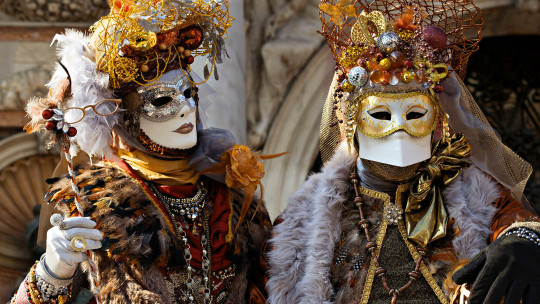
SEASON 3, EPISODE 10: Carnevale di Venezia
DATE: February 23, 1993
FLASHBACKS:
Clarice – Lecter saying that they are a week into Lent.
Hannibal - Hannibal makes his own handcuff key
Hannibal - Hannibal escapes custody wearing Pembry’s Face
ARTWORK FEATURED:
Al Thani Jewels – Jewel Covered Dagger
Al Thani Jewels – Gold Brooch
Al Thani Jewels – Pair of earrings
NOTES:
This episode is heavily inspired by the 2018 theft of Jewels from the Dodge’s Palace in Venice. The jewels were from the “Treasures of the Mughals and Maharajas” showcasing almost 300 gems and jewels from the private collection of Hamad bin Abdullah Al Thani of the royal family of Qatar.
The thieves nabbed several pieces of jewelry and then blended in with the rest of the crowd in St.Mark’s square.
This episode keeps the basic concept but places the event earlier in the month during Carnivale.
The theft is quickly discovered and Clarice and Johnny happen to be in the area and immediately try to find the culprit. Of course, the problem is nearly everyone is wearing a mask.
SEASON 3, EPISODE 11: The Second Moment of Creation
DATE: March 1993
FLASHBACKS:
Crawford – Crawford gives Clarice a fake offer to give to Lecter
Clarice – Lecter confronts Clarice on her fake offer
ARTWORK FEATURED:
The Birth of Venus by Botticelli
NOTES:
The title refers to the role that art plays in the world. That the world was created, but the second moment of creation is when made created art. It is a very human thing. We have art at our cores.
The episode is inspired by the fact that sometimes when a museum has to move a very important piece, they will use a decoy mover or multiple movers so that nobody knows which one is the real painting.
It is also inspired by a painting by Francisco de Goya from 1778 called Children with a Cart that was stolen while en route from Ohio to the Guggenheim Museum in New York City. Its value was $1.1 million.
A priceless painting is being moved from the Uffizi going to be displayed in America. But it’s front-page news,
Clarice goes to one of the forgers she has put into jail. Crawford has told her that she can offer him privileges if he works with them. This is a lie, but Clarice does not know it. She tells the forger that she will help him get out faster and he will have more access to phone calls, better food, etc if he will paint for her three duplicates of the painting being transferred. He agrees.
Three forgeries are created and the real piece, plus the forgery are crated and sent in different directions around Florence.
Johnny and Pazzi have drinks together and talk about their time at Quantico. Pazzi gets drunk enough that he lets slip some information about his plans to capture Dr.Fell who he believes to be Dr.Lecter. He does not remember telling Johnny this the next day. Johnny at first believes this to just be silly drunken ideas…but when he begins to think about it over the next few days he realizes that it is the truth. Once he understands this, he realizes that Clarice – who had interviewed Lecter – would know Lecter if she saw him, and thus must be fully aware of the fact that the man she has been in contact with on and off for the last few years is really Doctor Lecter. Worse still…Last season Johnny realized that Clarice was in love with Dr.Fell, and realizes that this means she is in love with Lecter. He suspects her love is what keeps her from turning him in. He thinks about turning Lecter in immediately, but he realizes since Clarice is aware of Lecter, that ultimately she would get in a lot of trouble as well if Lecter were caught. He ponders what to do, unsure just what to think.
Once the painting is safely in America, Crawford lets the forger know that he was duped by Clarice. Furious, he has his men on the outside plot revenge on her.
March 8 – The Moon moves into its nearest point to Earth, called perigee, at the same time as its fullest phase of the Lunar Cycle. The Moon appears to be 14% bigger and 30% brighter than the year's other full moons. The next time these two events coincided will be 2008
March 16- British fashion designer Alexander McQueen shows his first collection, partly inspired by The Silence of the Lambs film. Obviously, the film does not exist in this universe - HOWEVER - Clarice is shown looking at a Vogue spread featuring a couple of the pieces from the collection.
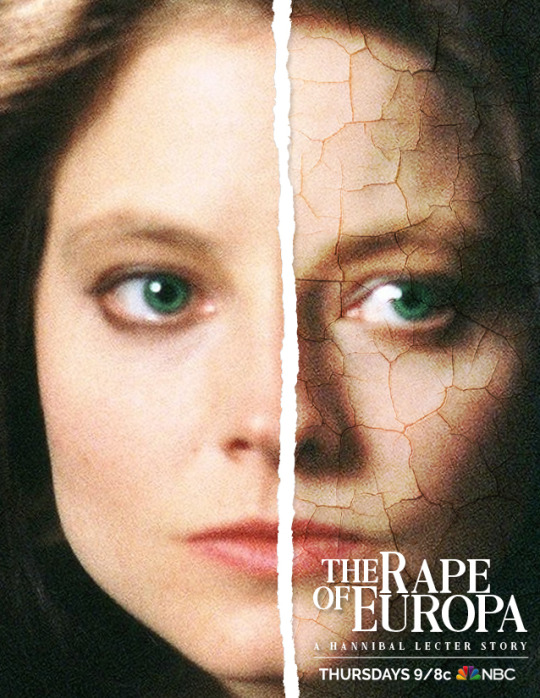
SEASON 3, EPISODE 12: Art and Artifice
DATE: April 1993
ARTWORK FEATURED:
Light and Colour by J. M. W. Turner
Shade and Darkness by J. M. W. Turner
Nebelschwaden by Caspar David Friedrich
NOTES:
This episode is heavily influenced by the Frankfurt Art Theft of 1994, when three paintings were stolen from a German Gallery. 2 of the paintings were on loan from the Tate museum. The Tate museum devised a plan – Operation Cobalt – to buy back the paintings from the Mafia with the insurance money they had received from the theft. They would up actually making a profit!
Several pieces of art go missing from a gallery in Italy. It is believed to be at the hands of the Mafia. Clarice manages to find out who they think stole the paintings and poses as Elizabeth Chase in an effort to “buy” them for an interested client. She has the insurance money for the Mafia to see – so they know she is for real. It is, of course, a ruse and several members of the Mafia are taken to jail. They threaten revenge on Clarice.
Ardelia wonders if the FBI can use members of the Belle Arti to lure Il Monstro into attacking and essentially ambush him.
Jonny, having discovered that Dr.Fell is Hannibal Lecter wonders if he should confront Clarice about that fact, but he is not entirely sure how to do so.
April 19 – Waco siege: A 51-day standoff at the Branch Davidian compound near Waco, Texas ends with a fire that kills 76 people, including David Koresh. This would be big news in the background of the episode, especially for the F.B.I teams. Several of Crawford’s men are required to head back home.
SEASON 3, EPISODE 13: Violent Delights
DATE: May 1993
ARTWORK FEATURED:
Adoration of the Shepherds by Gerard van Honthorst
Birth of Christ by Gherardo Delle Notti
Dispute with the Doctors by Manfredi
Death of Adonis by Sebastiano del Piombo
Piramo and Tisbe by Gregorio Pagani
Disbelief of St.Thomas, school of Caravaggio
NOTES:
27 May – Via dei Georgofili Massacre: A car bomb planted outside the Uffizi Gallery in Florence by the Mafia kills five people and irretrievably destroying several pieces of art and badly damaging many others. This episode is heavily influenced by this event.
While it first appears that the bombing is in retaliation for the passing of a new measure in prison that greatly limited freedoms of prisoners based on their crime. It applied heavily to imprisoned Mafia members and freed Mafia members retaliated.
This episode explores the fact that while the law is stated reason for the bombing, the choice of the Uffizi has to do with the police participating in the fake sale of art in order to lure in the Mafia and imprison some of its members.
Clarice has made her name in the city for being disruptive in the art world. The Mafia has noticed her and Il Monstro has noticed her as well. We see a scene of a Mafia boss and Il Monstro meeting. We do not see Il Monstro – just the back of his shoulder. The Mafia boss asks if he would be amenable to taking care of Clarice – for which he will be adequately compensated. Il Monstro agrees.
Dr.Fell lectures to the Studiolo on Dante’s Infero. He discusses Pazzi and Judas Iscariot, who both died by hanging. The Studiolo considers the lecture to be a resounding success,
Pazzi meets Dr.Fell as he leaves the lecture. Once only the two of them remain, Lecter shows Pazzi a slide he forgot – a slide of his ancestor hanging. He chloroforms Pazzi. Pazzi wakes, tied up, his mouth taped. Lecter asks him if it was Mason Verger he sold Lecter to and Pazzi confirms that it was. Pazzi tries to negotiate – he will have Laura bring money. Lecter says he doesn’t need the money and begins to make a hangman’s noose from an extension cord. He puts the noose around Pazzi’s neck, slits open Pazzi’s bowels and throws Pazzi off the balcony before quickly escaping.
SEASON 3, EPISODE 14: Accademia di Belle Arti
DATE: June 1993
ARTWORK FEATURED:
San Bernardino alle Ossa, Ossuary of Bones
Visconti Coat of Arms in Milan
NOTES:
A list with Il Monstro's victim's surfaces and it confirms to Clarice that indeed he is killing men from the board of the Art School that he was rejected from - the Belle Arti.
Clarice’s own name has been added to the list at the bottom, Il Monstro knowing that she is out and about looking for him. The FBI insists she keeps a low profile for a little while. She books a B&B in the country, but just before she leaves, a note from the Doctor arrives, and she chooses to go to that address instead. He has a villa outside of town he has rented for a little while and assures Clarice its owners met no foul end. For a week they talk, drink, eat, laugh, and mostly try to solve the Il Monstro Case, going over the evidence. The various board members have come and gone over the years, and so the board member kills look random - until the comparison of their years on the boards is compared. From there, they determine the years in which all of the dead board members were active. Once they narrow down the years, then they are able to look through a list of rejections given by that board. It’s not a small list, and they must cull through it as well. As Clarice works alongside Lecter on this, she is also calling her team back in town and “offering suggestions” in the hopes that they come to the same conclusions she is. Clarice and Lecter, as well as Clarice’s team ultimately come up with two names - but one of those people is dead - so it narrows it down to one. The problem now is finding where that person is...
Over the week with Lecter, there is a lot of discussion about Clarice’s father. When searching for the killer, Hannibal asks her "Isn't this what you wanted? To be back to the chase?” She says she is no longer sure. They talk more about her father and the lambs, and Hannibal Lecter shows her the Ossuary of Bones in San Bernardino alle Ossa. He tells her that her father is just like these bones - this is what time has reduced him to. Her father cannot judge her, that she doesn't have to fight crime because she thinks it will make him proud - he already is proud. She doesn't have to fight crime to bring him back - he will never come back. She must make peace with that. He tells her father is not a saint, to which she replies "Neither am I." which shocks Hannibal, as he has idealized her for quite some time.
She says he once accused her of forgetting who he is, what he is, what he is capable of. She looks at him and says she hasn't forgotten, she doesn't care. They kiss and are about to go to bed together when the phone rings, and it is The Art Crime Team and the Behavioral Science team saying they have a location on Il Monstro - they are going in. Clarice says she is on her way and leaves Hannibal Lecter to his thoughts.
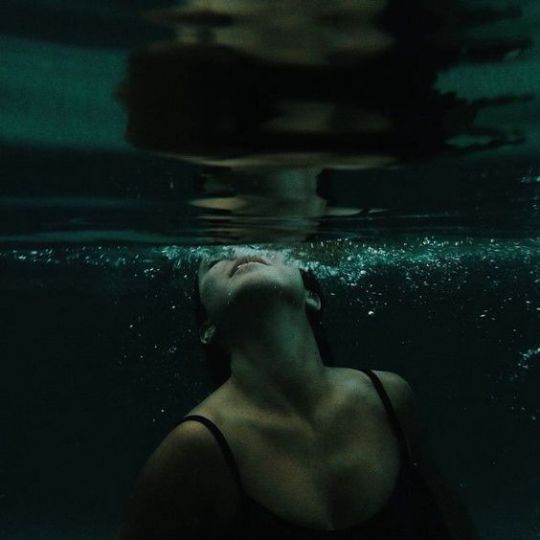
SEASON 3, EPISODE 15: A Pound of Flesh
DATE: June 1993
FLASHBACKS:
Crawford - Crawford and his team surround the home of the suspected Buffalo Bill, breaking down the door.
Crawford - The home Crawford and his team enter winds up being incorrect, and Crawford realizes that Clarice may be in grave danger.
Clarice - Clarice investigates James Gumb, knocking on his door. She soon finds he is Buffalo Bill, and he escapes into his basement, where she quickly follows.
Clarice - Clarice and Jame Gumb stumble about his basement, and she ultimately shoots and kills him.
Clarice - Clarice is on the front page of many newspapers for having killed Buffalo Bill. She receives a letter from Hannibal Lecter.
ARTWORK FEATURED:
Perseus and Andromeda by Titian, The Wallace Collection in London
Various sculptures and pieces of glass in Il Monstro’s studio
NOTES:
The title of the episode is a famous phrase from The Merchant of Venice.
Clarice has been notified that her team is closing in on Il Monstro and she drives from the country to meet her team. Unfortunately, when Clarice’s team and Crawford’s team reach Il Monstro’s location, they quickly find that the name they have is wrong. After a moment of realization, Jack Crawford understands that Clarice is in great danger.
Driving in the country, Clarice is abducted by Il Monstro.
Scenes of Clarice’s team being led to the wrong location, only to have Clarice abducted are interspersed with flashbacks of the Buffalo Bill Case when Jack Crawford accidentally send Clarice to Buffalo Bill while they chase a lead that winds up not being the right location.
Il Monstro takes Clarice to Venice. He has a small art studio - far away and secluded - along with glass blowing supplies. He reveals that his name is Franceso Grandin, but that he has been living under an alias.
He considers what he will do with her. He threatens her with molten glass at the end of a pole. How to kill her - and how to pose her? What piece of art does she inspire? He ultimately decides he will drown her in the narrow canal just outside of his studio. Will she be Andromeda? Maybe Ophelia? He decides instead she will be The Drowned Martyr.
As he is speaking, Hannibal Lecter manages to find his way to Clarice. He was not far behind her when she was abducted, and followed Francesco the whole way. He tells Clarice this, but we do not SEE it happen, as this scene should be suspenseful - we should not know Hannibal is going to rescue her.
Francesco and Hannibal fight, and Francesco manages to burn Hannibal’s arm with molten glass badly enough that he pauses for a few seconds - long enough for Il Monstro to pin him down. Tied up, Clarice and Hannibal cannot do much, but Hannibal slowly begins to work on getting out of his bonds.
Francesco leaves Hannibal and goes back to Clarice. He drags her outside and she screams, more concerned for Hannibal than herself. She struggles the entire time but is gagged and thus cannot make much noise. Her ankles and wrists are bound and she is thrown into the Canal. She struggles with her bonds.
Back in the studio, Francesco speaks to Hannibal, and much like he did with Clarice considers how he should kill and display Hannibal. “You don’t know who I am, do you?” Hannibal asks him. When he Francesco moves close to Hannibal’s face, suddenly Hanniba’s hands come out from behind him - he had managed to come loose from his bonds. With a clay cutter from a table littered with sculptures, Hannibal Lecter slits Il Monstro’s neck as he advises Francesco that a monster should learn to recognize another monster.
Clarice continues to struggle with her bonds, having gotten her ankles free, but it is too late and she finally loses consciousness. Suddenly Lecter appears in the water beside her. He grabs her around the waist and brings her up to the surface. He performs mouth to mouth, and Clarice vomits up some water but does not regain consciousness.
Knowing that police will soon arrive - both to deal with the commotion of his just having killed a man, as well as the F.B.I. coming in search of Clarice, Lecter carries Clarice to a small abandoned studio not far from the one they just left.
He strips them of their wet clothes and holds her close to warm her. It’s May, and the water int he canal isn’t cold enough to make her hypothermic, but she is still cold, shaken and weak from having nearly drowned. He kisses her hands to warm them and realizes suddenly she’s regained consciousness. She is relieved to find that he is alive, and he kisses her forehead and tells her she’ll be alright. After kissing her forehead, he looks at her, overwhelmed and kisses her lips and she kisses him back. He pulls away after a moment, and she says “Don’t stop.” With three years of sexual frustration having pent up and the relief at finding one another alive, they make love.
Clarice wakes to the sound of sirens and helicopters. She sits up and looks around and finds that Hannibal Lecter is gone. She goes outside to find Johnny, Crawford, several other team members, and the Italian Police outside calling for her.
Clarice runs to Johnny and he expresses relief that she is alright. He tells her that after going to the wrong place, they knew she was in danger. With some quick thinking, they ultimately found Il Monstro’s studio and his body - his neck slit, but when they couldn’t find her, they feared the worst. She is given credit for the kill.
Clarice is once again in the news - now mostly in Italy rather than America. Crawford assures her that he is going to do his best to get her on his team at Behavioral Science.
We see a flashback of Clarice just after the Buffalo Bill killing receiving a letter from Hannibal Lecter. We then see her going through her mail in the present day. We can tell she is expecting a letter from Lecter. We see her disappointment when there isn’t one.
CREDIT: “It’s Art that Kills Us” poster uses an edited and cropped photograph by Tommy Liddel.
#hannibal#hannibal lecter#clarice starling#silence of the lambs#clannibal#the rape of eurora#fan fic#fanfictio
36 notes
·
View notes
Quote
Die Musikerin spricht mit Gästen wie Andreas Dresen, Amanda Palmer und Phillip Grütering von Deichkind über die Vielfalt von Kunst und Kreativität.Während manche Künstler*innen sich durch die Coronakrise kreativ gehemmt fühlen, erkunden andere neue Wege, sich künstlerisch auszudrücken. So war es wohl auch bei der ehemaligen Wir-sind-Helden-Frontfrau Judith Holofernes: Über ihre Patreon-Seite hat die Musikerin in den vergangenen Monaten die ersten sechs Folgen ihres neuen Podcasts „Salon Holofernes“ veröffentlicht – jetzt möchte sie ihr neues Projekt...
https://www.musikexpress.de/salon-holofernes-judith-holofernes-teilt-ihren-podcast-mit-der-welt-1544019/
0 notes
Photo
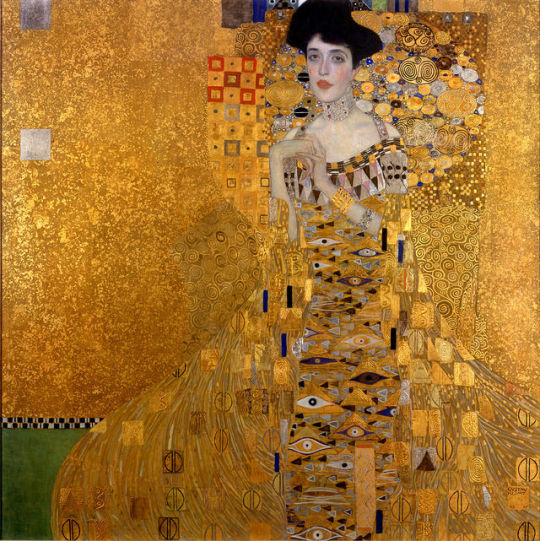

By Kimberly Bradley * 20 September 2016
Pleading… or challenging? In her portraits, it’s difficult to read what might have been going on behind the limpid, dark eyes of Adele Bloch-Bauer, the only women that fin de siècle Austrian artist Gustav Klimt portrayed not once, but twice. But this is clearly a woman of depth and mystery. In a new exhibition Klimt and the Women of Vienna’s Golden Age at New York’s Neue Galerie, both portraits – the iconic, long-controversial Adele Bloch-Bauer I (1907) and the lesser-known but no less stunning Adele Bloch-Bauer II(1912) – will be shown together for the first time in more than a decade.
The exhibition includes portraits of other women, but Adele remains the most iconic. It is she, as a ‘woman in gold’, who anchors the works that represent the apex of Klimt’s ‘golden phase’. (Speculation is, too, that she is the half-nude figure in Klimt’s Judith and the Head of Holofernes, and possibly the closed-eyed, blissed-out woman in The Kiss.) It is she who embodies both the vulnerability and strength of women in turn-of-the-century Vienna, a society in profound transition.
In postwar Vienna her image became a symbol of Austrian culture – Adele Bloch-Bauer I was long called ‘the Austrian Mona Lisa’. The painting later became an icon of justice – the 2015 film Woman in Gold is the Hollywood version of the tale of the painting’s confiscation from the Jewish Bloch-Bauer family during World War Two and the long but ultimately successful struggle for restitution by Bloch-Bauer’s niece Maria Altmann. Over the past century, many viewers have asked: who was Adele Bloch-Bauer?
‘Symphony in gold’
Bloch-Bauer was born Adele Bauer in Vienna in 1881. The daughter of a bank and railway director, she led a privileged, cultured childhood; at 19, she married Ferdinand Bloch, a sugar magnate 17 years her senior. Ferdinand adored the young woman, enough to make her last name part of his own. (Both became Bloch-Bauers; their siblings married each other, too, making for two couples with the same hyphenated last name.) The family were avid art patrons, not only collecting but also commissioning paintings – and the maverick, kaftan-clad Gustav Klimt was one of their favorite artists.
The first portrait of Adele was originally discussed in a letter the then 22-year-old wrote to Klimt in 1903. Ferdinand commissioned it as a gift for Adele’s parents’ anniversary a few years after Klimt co-founded the Vienna Secession, and not long after his scandalous, allegedly pornographic murals saw the University of Vienna blacklist the painter from state commissions.
Adele Bloch-Bauer I was first publicly displayed in 1907: a stunning scene in oil and gold leaf; it shows a flushed, bare-shouldered Adele in a stylised throne, gazing at the viewer with both vulnerability and pride, her hands oddly clasped in the foreground – one of her fingers was deformed, which she often attempted to conceal in her many sittings with the artist, who created some 200 studies for the portrait. The painting’s background is a lush riot of glittering Oriental and erotic symbolism – triangles, eyes, eggs. “The golden image of Adele Bloch-Bauer I cast a spell over me even as an art history student,” says Tobias Natter, a Vienna-based historian and curator of the Neue Galerie exhibition. “For me it’s a symphony in gold, a unique emblematic triumph.” It is considered an Art Nouveau masterpiece.
The later painting is a dramatic departure: “How could Klimt have evolved from the first painting?” asks Natter. “With Adele Bloch-Bauer IIfive years later, he does something completely diffferent, an enormous stylistic evolution is clear.” The painting shows the raven-haired Adele in a wide-brimmed black hat standing majestically, frontally facing the viewer; the background a tableau of brightly colored patterned wallpaper. “What excites me about this image is the renewal through the power of colour.
All that glitters
Here, Bloch-Bauer is very much the grande dame, but her eyes reveal a more mature melancholy. Despite privilege, life hadn’t always been kind to her. Altmann, who died in 2011, remembered her aunt as a “rather cold, intellectual woman who was very politically aware and became a socialist. She wasn't happy. It was an arranged marriage but she was childless, after two miscarriages and the death of a baby. I remember her as extremely elegant, tall, dark and thin. She always wore a slinky white dress and used a long, gold cigarette holder.”
Gustav Klimt’s women exuded not only a profound eroticism, but also strength and confidence. Critics and art historians over the decades have dubbed Klimt art’s “Frauenversteher” – “understander of women,” and many speculated that Adele and Klimt had an ongoing affair. It was never confirmed. In his paintings, Bloch-Bauer always appears sovereign, grand, even exalted.
In at least one area of her life, she very much was. Like others depicted in the Neue Galerie exhibition, she belonged to a largely Jewish bourgeoisie – whose women wielded considerable social and intellectual power through hosting salons. One Berta Zuckerkandl, for example, was of slightly lower social stature but was known as ‘the puppeteer of the Viennese cultural scene’ for all the connections she made, including introducing Klimt to Auguste Rodin; the Secession was apparently conceived over conversations in her living room. Many society women, like Szeréna Lederer (who, over 40 years, amassed the largest collection of Klimt in private hands at the time) and her daughter Elisabeth, appeared in Klimt portraits; the artist began to focus entirely on women as subjects after 1900.
Bloch-Bauer’s weekly salons were frequented by the likes of composers Gustav Mahler and Richard Strauss; author Stefan Zweig was also a visitor. Later, her doctor Julius Tandler – who was also a politician, advocating for social housing and the Austrian welfare state – influenced her toward social reform and women’s suffrage. The Neue Galerie exhibition not only focusses on the shifting roles of women at the time but also on the importance of fashion and design in not only Klimt’s work but in a ‘modern’ Austrian woman’s life. For the many drawn studies for Adele Bloch-Bauer I, Bloch-Bauer posed in stunningly pleated – but completely uncorseted, loose, and flowing – ‘reform’ dresses, at the time worn by bourgeouis women with progressive tendencies.
Bloch-Bauer died of meningitis in 1925, at only 43. Fate perhaps mercifully allowed her to miss the dark years that would descend upon Austria in the 1930s; after her death, her room became a kind of shrine to Klimt’s vision of her. After Austria was annexed by the National Socialists in 1938, the Bloch-Bauers’ art – numerous drawings by Klimt, several landscapes, of course the images of Adele – was confiscated and fell into ownership limbo until both portraits came to hang in Vienna’s illustrious Belvedere museum in the postwar years. There they would stay until 2006, when, after a long and drawn out series of court decisions, the paintings were returned to Altmann, the last surviving direct relative of Ferdinand Bloch-Bauer.
Overwhelmed by prohibitive insurance and storage costs, Altmann sold Adele Bloch-Bauer I to Ronald Lauder – heir to the Estée Lauder cosmetics empire, and founder and director of the Neue Galerie – with the stipulation that it must always be on view; the later painting was sold at Christie’s in 2006, and is currently part of a special loan to the Museum of Modern Art in New York. “It’s not easy to borrow the second painting,” says Natter, explaining the infrequency of the two Adeles being shown together.
In April 2016, the new neighborhood currently under construction around Vienna’s main train station got a new street: Bloch-Bauer Promenade, named after both Adele and Ferdinand. Austria “very much misses” the paintings, especially Adele Bloch-Bauer I, says Natter. But now they “belong to the whole world.”
If you would like to comment on this story or anything else you have seen on BBC Culture, head over to our Facebook page or message us on Twitter.
http://www.bbc.com/culture/story/20160920-who-was-the-woman-in-gold
2 notes
·
View notes
Link
The UNESCO-listed capital of Malta stands proudly on one of Europe's grandest harbors, surrounded by some of the mightiest fortifications in the world.
Explore this fascinating city with our list of the top tourist attractions in Valletta.
1. Saint John's Co-Cathedral
Saint John's Co-Cathedral reflects the wealth and importance of the Knights of Malta, who protected Europe and the Catholic faith from attacks by the Ottoman Turks in the 16th century. The most renowned artwork in the church is The Beheading of Saint John the Baptist by Caravaggio in the Oratory.
The various chapels of Saint John's Co-Cathedral reflect the different "langues" (regions) of the Knights of Malta who hailed from many different countries in Europe. Among the eight chapels are a few must-see highlights: The Chapel of the Langue of Aragon (the region of Catalonia and Navarre in Spain) features Mattia Preti's painting of Saint George on a white stallion after slaying a dragon. The Chapel of the Langue of Italy displays the famous work of Saint-Jerome Writing by Caravaggio.
The Grand Master's Palace has many quaint shops, cafés, and restaurants. A great place to stop is the famous establishment Caffe Cordina (244 Republic Street), a fancy café that serves traditional Maltese pastries along with coffee and tea.
Address: Saint John's Street, Valletta
2. Grand Master's Palace
Valletta's most monumental building, the Grand Master's Palace stands in the center of Palace Square, which is often used for traditional ceremonies. Grand Master Fra Pietro del Monte commissioned the palace in the 16th century as a residence for the Knights of Malta. Part of the building is now used as the Presidential Palace, serving as the office for the President of Malta. The rest of the building is open to the public as a museum.
The enormous State Rooms are richly decorated with gilded moldings and works of art, such as a series of murals that illustrates a complete narration of the Great Siege of 1565. The Hall of the Ambassadors, also known as the "Red Room," is adorned with portraits of the Grand Masters, who led the knights to victory. One of the paintings depicts the dignified-looking Grand Master Jean de Vallette, founder of the city of Valletta.
3. Grand Harbor
The entire harbor is surrounded by massive fortifications, bastions, and defensive towers. This formidable setting was the scene of the Great Siege of 1565, the most famous event in Malta's history. Led by Grand Master Jean de Valette, the knights heroically defeated the ruthless Ottoman Turk invaders.
The harbor branches off into smaller creeks (shaped like a multi-pronged fork). In these quiet ports, there are many yacht marinas and boat docks. These ports around the Valletta Grand Harbor provide enough docks for thousands of boats, making it one of the largest marinas in the world.
The entire Grand Harbor area encompasses a semicircle of densely populated little towns, including Kalkara, Vittoriosa, Cospicua, Senglea, Paola, and Marsa. Just across from Valletta, the towns of Vittoriosa, Cospicua, and Senglea, known as the "Three Cities" were the original settlement of the Knights. These towns are filled with historical monuments, such as auberges of the knights, beautiful Baroque churches, and important military forts. The best way for tourists to discover the Grand Harbor is by taking a guided boat tour.
4. National Museum of Archaeology
The National Museum of Archeology is housed in the former Auberge de Provence, the historic residence of the knights originating from the Provence region in France. The building dates to 1571 and is a wonderful example of Baroque architecture. The Grand Salon is especially noteworthy, with its richly painted walls and wood-beamed ceiling. The museum's exceptional archaeology collection tells the story of Malta through a chronological presentation. Exhibits include prehistoric artifacts and architectural elements found at megalithic sites, as well as ancient Roman objects and medieval antiquities.
The museum is renowned for its Prehistoric collection, an extensive array of artifacts from the Maltese Islands' megalithic temples. These Neolithic-era archaeological finds include 6,000- to 7,000-year-old pottery, ornaments, altars, limestone statuettes, terra cotta bowls, and cult utensils. One room contains models of the five best-preserved temples. The headless "Fat" statues of the Tarxien Temples are displayed here.
A small room houses the The Sleeping Lady, considered a masterpiece of prehistoric art. This tiny figurine of a woman lying on a couch reveals the expression and emotion of centuries ago.
Address: Auberge de Provence, Republic Street, Valletta
5. Upper Barrakka Gardens and Military Ceremonies
The picturesque Upper Barrakka Gardens encircle part of the city's old fortifications, built on Valletta's highest point. The peaceful and shady gardens are beautifully laid out with fountains, flower beds, rows of archways, and statues of prominent historical figures including Winston Churchill. There are multiple viewpoints from different outlooks around the garden, offering awe-inspiring panoramas of the Grand Harbor. It's possible to see across to the towns of Vittoriosa, Cospicua, and Kalkara.
This space is now used for outdoor weddings and ceremonial events. Every day, a traditional ceremony at noon is performed by members of the Malta Heritage Society dressed in authentic British Artillery uniforms. A tribute to Valletta's military history, this ceremony includes firing the cannons as a salute.
Tips for Tourists: The Upper Barrakka Gardens is in the heart of the city next to Castille Place. To arrive here, go to the Victoria Gate and turn left past the Church of Saint Mary of Jesus onto Saint Ursula Street. The entrance to the Upper Barrakka Gardens is at the end of the street. There is also an elevator at the foot of Saint Barbara Bastion that goes up 60 meters to the Upper Barrakka Gardens.
Address: Saint Ursula Street, Valletta
6. Casa Rocca Piccola: An Aristocratic Maltese Home
The current owners are the 9th Marquis and Marchioness de Piro.
Visitors can take a guided tour to see the palace's elegant interior, including two dining rooms, a bedroom, the salons, and the small family chapel.
The rooms are decorated with antique 16th-century furniture, Murano glass chandeliers imported from Venice, and crystal chandeliers from Bohemia. In the Sala Grande, there is a distinctive portable chapel, a cabinet crafted from black lacquer with an altar inside that was designed for personal devotion.
Within the property is a family-run restaurant, La Giara, which prepares authentic Sicilian cuisine from the palace's old kitchens.
Address: 74 Republic Street, Valletta
7. Manoel Theater: One of the Oldest Theaters in Europe
This magnificent little theater was commissioned in 1731 by António Manoel de Vilhena, Grand Master of the Knights of Malta, to meet the local demand for operas, pageants, and theatrical performances. With this distinguished heritage, the Manoel Theater ranks among the oldest theaters in Europe. The lavishly decorated auditorium features gilded box seats and plush velvet chairs. Every seat in the house offers a good view, and the acoustics of the oval room are excellent.
Visitors may take a self-guided tour with an audio guide. There is also an interesting calendar of theatrical events including music concerts and classic opera. In January, the Manoel Theater hosts a two-week Baroque Festival featuring the music of Vivaldi and Bach.
Address: 115 Old Theater Street, Valletta
8. Collegiate Parish Church of Saint Paul's Shipwreck
An important landmark in Valletta, the domed Church of Saint Paul's Shipwreck is one of the oldest churches in Malta (dating back to the 1570s.) As befits a church dedicated to Malta's patron saint, the interior is sumptuous and houses venerated relics. Pope Pius VII donated the most precious relic, the block upon which Saint Paul was said to have been beheaded, as well as what is believed to be part of his wrist bone.
Visitors should take time to admire the church's ceiling frescoes, which depict Saint Paul's brief sojourn in Malta and were painted at the turn of the century. The main altarpiece displays a painting of Saint Paul and Saint Luke in a scene of the shipwreck. The church's marvelous gilded wooden statue of Saint Paul is paraded through the streets of Valletta on February 10th every year. This date commemorates the day Saint Paul's shipwreck occurred and is celebrated with much festivity.
Address: 74 Saint Paul Street, Valletta
9. National Museum of Fine Arts
The monumental staircase at the entrance makes a grand impression, worthy of Valletta's finest art collection. The museum's collection represents important works of Maltese art from the 12th century to the 20th century, as well as noteworthy pieces by other European artists.
There's an great grouping of works by the popular artist of Malta, Mattia Preti, who was from Calabria in Southern Italy. His most renowned work on display here is the Baptism of Christ painting. The museum also displays a few masterpieces by Italian artist Guido Reni and the exceptional Judith and Holofernes painting by Valentin de Boulogne. Another exquisite painting that stands out in the collection is the early Impressionist View of the Grand Harbor by J.M.W. Turner.
Address: South Street, Valletta
10. Valletta Waterfront
Overlooked by many tourists, the Valletta Waterfront is a popular spot among locals. The row of buildings was commissioned in the 18th century by Grand Master Pinto for the purpose of storing goods such as grain, vegetables, and fish.
The warehouse buildings have been beautifully restored, and the pathway has been enlarged. Fringed with shady trees and leafy palms, the spacious waterside promenade is lined with trendy restaurants. This is one of the best places to visit in Valletta for an atmospheric meal by the harbor.
From : https://wikitopx.com/travel/top-10-things-to-do-in-malta-701890.html
0 notes
Photo

1 note
·
View note
Text
Sartle School of Art History: Baroque Art
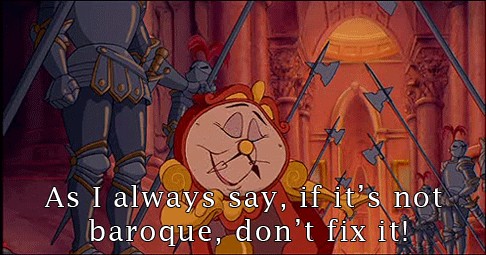
Baroque art started because the Catholics got all jealous that people were choosing Lutheranism over Catholicism during the Protestant Reformation in the mid 16th century and they wanted to show everyone just how amazing they were. Criticism for little things like “papal primacy” (meaning all the other bishops have to bow down to the Bishop of Rome) and “supremacy” from the Protestants started driving people away from the Catholic Church.
In response, Catholics decided that they needed to get back in touch with the common people. But because the common people were pretty much always illiterate during this time, they had to connect with them through art – more specifically, the most over the top art this world had ever seen. This included intense scenes of martyrdom, religious visions, violence, death, all using movement, light, and rich color. This was a fierce contrast to the rather boring and planar subjects of the Renaissance. Sure, the Renaissance may have been the rebirth of culture, but that doesn’t mean that it wasn’t a bit of a snooze-fest.
I mean it was this type of stability and poise found in Renaissance works:
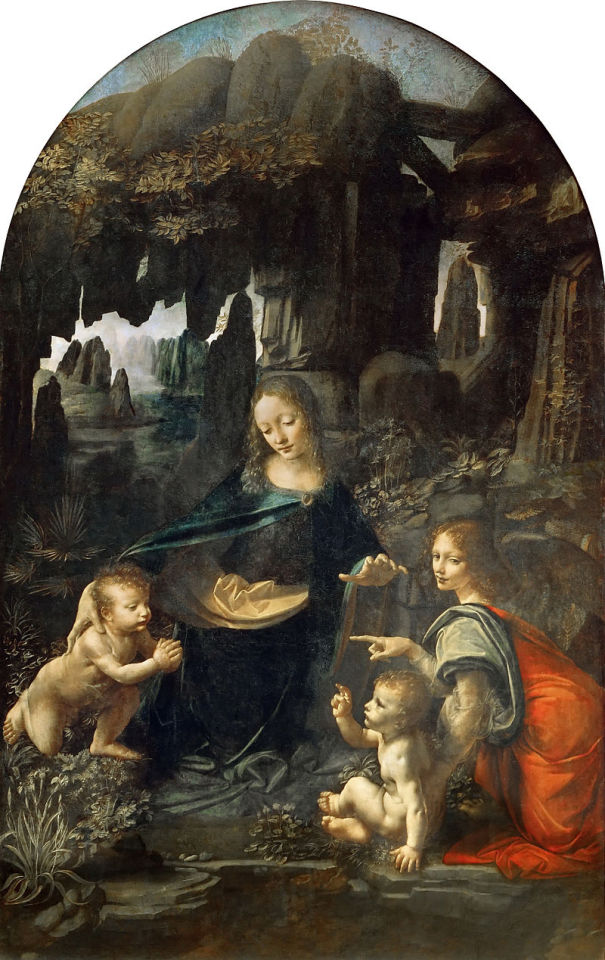
Virgin of the Rocks by Leonardo da Vinci at the Louvre
Vs. this rather disturbing depiction of a Baroque sh*tstorm:
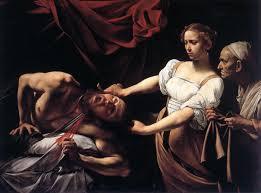
Judith Beheading Holofernes by Caravaggio at the National Gallery of Ancient Art
And this simple and straightforward piece (granted the unicorn is pretty awesome):
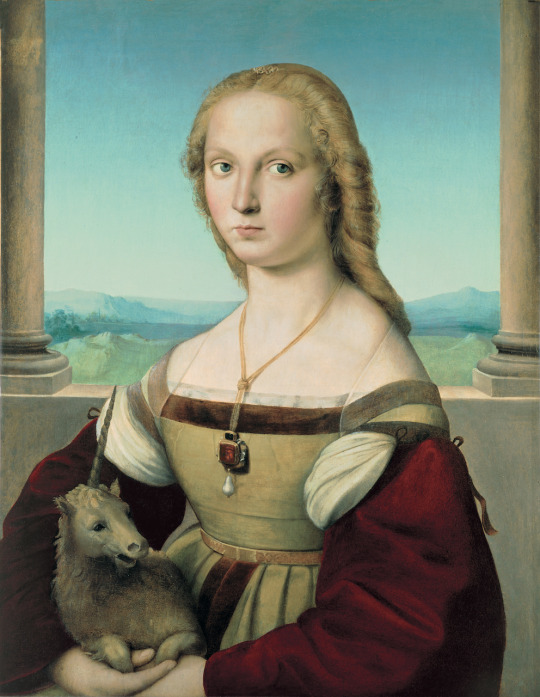
Portrait of a Young Woman With Unicorn by Raphael at the Borghese Gallery
Vs. this orgasmic display of piety:
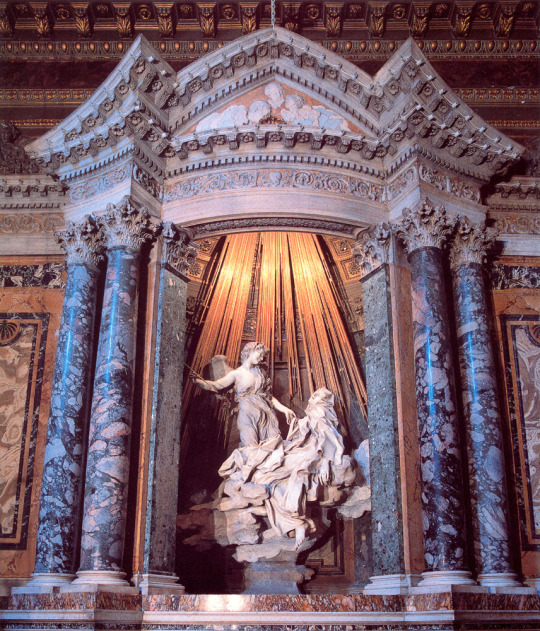
Ecstasy of Saint Teresa by Bernini in the Santa Maria della Vittoria
You can see the difference I’m sure. Baroque art has all of the passion of a teenage girl in drama club who is ready for her closeup. The term “baroque” actually started as an insult though. The literal meaning is “oddly shaped pearl” – a weak dis if I’ve ever heard one. It meant that a piece was too exaggerated and the details were too intense. Baroque artists didn’t really mind though because that was, in fact, the point. And everyone knows that it’s the job of a previous movement to hate on the movement that comes after it as it is the job of the next movement to derive a large amount of joy and satisfaction from disappointing their elders.
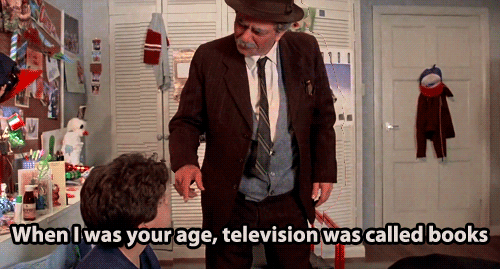
The star players of the movement were Diego Velázquez, Peter Paul Rubens, Caravaggio, Bernini, Rembrandt, Vermeer, Artemisia Gentileschi, and many others. Though the movement was spread all over Europe from Spain to the Netherlands, there was one important thing that all of these artists had in common, and that was above all else drama, drama, drama. Drama in light. Drama with movement. Drama in composition. It was the puberty of art history.
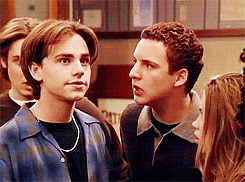
But not all of the drama was religiously centered. The countries that didn’t care whether the Catholics would win back all of the people who converted to Lutheranism used the baroque style just to like make self portraits and stuff. As exemplified by cute lil’ Rembrandt here.
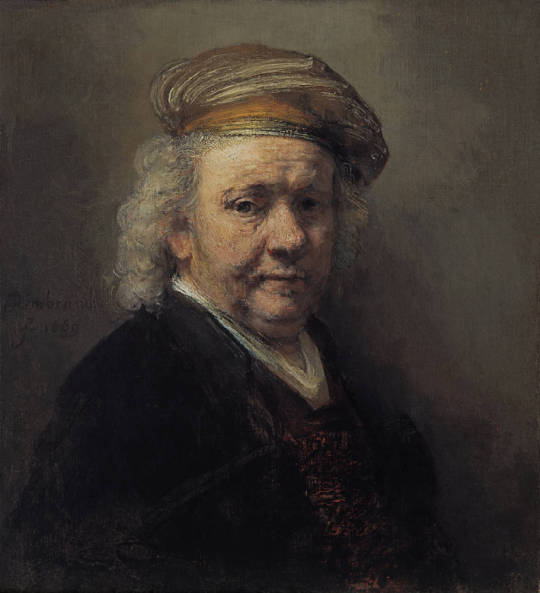
Self Portrait by Rembrandt in Mauritshuis
But then there was the quintessential Baroque artists dead set on scaring the illiterate people of Catholic countries into piety like Artemisia Gentileschi. She also had an ax to grind against men because she was raped by her tutor Agostino Tassi, who served a 7 month jail sentence and then was freed, while Gentileschi was tortured with thumbscrews and married off to some rando in Florence. Eventually the Medici family picked her up, and gave her a ton of money and artistic freedom resulting in her own version of Judith beheading Holofernes as well as many other paintings where the men get dead. She was really born in the exactly right time period to express all of the pent up fury that festered inside her due to the treatment of women.

Judith beheading Holofernes by Artemisia Gentileschi at the Uffizi Gallery
After about 130 years of this dark, dramatic stuff, the world decided that enough was enough. They needed a break. Something a little lighter and fluffier to fill their salons and hearts. The Catholic Church guilted/scared enough people back into their churches and people were just tired of beheadings, death, violence and crucified Jesuses. This resulted in the exact opposite extreme… Rococo. The marshmallow of art movements. The Baroque artists, like the Renaissance artists before them, were no doubt horrified at what would come next.
By Emily
#serious art history#baroque#caravaggio#drama#artemisia gentileschi#baroque art#art history#art#sartle school of art history#art history 101
0 notes
Text
Florencia es un sueño para todos aquellos que amamos el arte, la historia, la filosofía y la ciencia, no por algo es una de las ciudades más visitadas de Italia.
Florencia se encuentra al norte de la región central de Italia, en la región de la Toscana. El movimiento artístico llamado Renacimiento se inició aquí durante la segunda mitad del siglo XIV. Florencia es considerada una de las cunas del arte y de la arquitectura, por toda la ciudad se encuentran obras de arte de personajes como Lorenzo de Medici, Dante Alighieri, Giovanni Boccaccio, Filippo Brunelleschi, Leonardo da Vinci y Michelangelo Buonarroti.
En esta hermosa ciudad hay tanto que ver que se debe priorizar lo que uno desear conocer dependiendo del tiempo que se tenga.
Nosotras dedicamos 2 días a visitar Florencia, ya que llegamos un lunes por la tarde, después de dejar nuestras maletas salimos a recorrer la ciudad. Es una experiencia completamente distinta visitar Florencia por la noche mientras se come un rico helado italiano.
Aquí te dejamos nuestro itinerario y los lugares más importantes que debes visitar si estas en Florencia.
¿Qué visitar en tu viaje a Florencia en 2 Días?
Piazza del Duomo
La Piazza del Duomo es el centro religioso y espiritual de Florencia y debe ser el inicio todo viaje a esta ciudad. Aquí se encuentra la catedral de Florencia, el Duomo con su famosa cúpula de Brunelleschi, el Baptisterio de San Giovanni, el Campanario de Giotto, y el Museo dell’Opera del Duomo, donde se encuentran las esculturas originales que adornan los edificios de la plaza.
Piazza del Duomo
Il Duomo
La Catedral de Florencia, más conocida como el Duomo de Santa María del Fiore, es una obra de arte. Su construcción comenzó en 1296 y finalizo en 1368. La cúpula fue construida por Filippo Brunelleschi en el siglo XV, casi un siglo después que se finalizara la catedral. Se le consideró una de las más grandes obras del Renacimiento. El mosaico de la cúpula escenifica el Juicio Final y fue obra de Giorgio Vasari y Federico Zuccari.
No se puede dejar de subir a lo más alto de la cúpula desde donde podrán tener excelentes vistas panorámicas de toda la ciudad. Cuenta con 114 metros de altura y 463 escalones para llegar a la cima. El último tramo de la subida se realiza casi vertical entre las bóvedas interior y exterior.
Cerca de la entrada se encuentra una pequeña cripta donde se puede ver la tumba de Brunelleschi, que fue descubierta a mediados del siglo XX.
Horario: Lunes, martes, miércoles y viernes de 10:00 a 17:00 horas
Jueves de 10:00 a 15:30 horas
Sábados de 10:00 a 16:45 horas.
Domingos y festivos de 13:30 a 16:45 horas.
Lugar: Piazza del Duomo
Precio: Entrada 15€ (incluye catedral, cúpula, baptisterio, cripta, campanario y el Museo de la Ópera del Duomo).
Tickets Oficiales
El Campanario de Giotto
El esbelto campanario del Duomo es uno de los más bellos de Italia. Su construcción comenzó en 1334 siguiendo los planos de Giotto, quien no vería su obra terminada. El Campanario tiene un revestimiento de mármol blanco, verde y rojo, similar al de la catedral. Cuenta con 84 metros de altura y 414 escalones que llevan hasta la parte más alta desde donde se obtiene una vista majestuosa de toda la catedral, en especial de la cúpula y una hermosa vista de la ciudad de Florencia.
Precio: Ya incluida con entrada a la catedral
Baptisterio de San Giovanni
El Baptisterio de San Giovanni, de forma octagonal, es el edificio más antiguo que hay en Florencia y se encuentra frente al Duomo. Al igual que el Duomo y el Campanario, tiene un revestimiento de mármol blanco y verde. Lo más asombroso de su interior es el mosaico bizantino de su cúpula; aquí también se encuentra la tumba del antipapa Juan XIII, diseñada por Donatello.
El Baptisterio tiene tres puertas de acceso, de las cuales, la más importante es la que está situada frente al Duomo. “La Puerta del Paraiso” tiene 10 paneles de bronce con relieves que representan escenas del Antiguo Testamento; fue construida por Lorenzo Guiberti, a quien le tomo 26 años diseñarla. Los paneles que se exhiben son copias de los originales, que se encuentran en el Museo de la Catedral.
Horario: Todos los días 11:15am – 7pm
Lugar: Piazza del Duomo
Precio: Ya incluida con entrada a la catedral
Museo dell’Opera del Duomo
En el Museo Opera del Duomo se encuentran instrumentos y planos originales que fueron utilizados para la construcción de la Catedral. Aquí se hallan esculturas y piezas originales que fueron sustituidas por copias por motivos de conservación en la Catedral, Campanile y Baptisterio.
El Museo Opera del Duomo está situado detrás de la cúpula de la Catedral. En este antiguo palacio trabajaron artistas como Donatello, Brunelleschi y donde Miguel Ángel realizó su famoso David.
Horario: L – S de 9am – 7:30pm
Lugar: Piazza del Duomo
Precio: Ya incluida con entrada a la catedral
Piazza della Signoria
La Piazza della Signoria es la plaza más importante de Florencia; es el lugar donde se reúnen tanto los florentinos como los turistas. Esta bella plaza es un museo al aire libre, aquí se encuentra el Palazzo Vecchio, las esculturas de Adán y Eva, la copia del David de Miguel Ángel (que luego fue llevado a la Galeria de la Academia), la Fuente de Neptuno con sus ninfas, la Judit y el Holofernes de Donatello, el Perseo de bronce de Cellini que muestra la cabeza de Medusa y Cosme.
Palazzo Vecchio
El Palazzo Vecchio es la sede del gobierno de Florencia, el ayuntamiento de la ciudad. En la entrada del Palacio se encuentra la copia del David de Miguel y Hércules y Caco de Baccio Bandinelli. Una de los salones más importante es la Sala del Cinquecento, con 54 metros de longitud, 22 metros de ancho y 17 metros de altura, es la sala más grande de Florencia. En la actualidad la Sala del Cinquecento es usado para audiencias y eventos especiales.
El Palazzo Vecchio es uno de los museos que abren hasta tarde durante la primavera y verano.
Horario: Viernes – Miercoles de 9am – 11pm
Lugar: Piazza della Signoria
Precio: Entrada 10€
Tickets Oficiales
El Ponte Vecchio
El Ponte Vecchio es una de las imágenes icono y representativa de Florencia. Con sus casas y tiendas colgantes, el Ponte Vecchio es uno de los puentes más famosos del mundo, también es el puente de piedra más antiguo de Europa. Durante la Segunda Guerra Mundial, fue el único de los puentes de Florencia que no fue destruido por las tropas alemanas.
El Ponte Vecchio es el símbolo del romanticismo por la cantidad de candados que son colocados en éste como señal de amor; en la actualidad cada cierto tiempo las autoridades quitan los candados por la seguridad de la estructura.
Lugar: Entre Santa María y Guicciardini.
Iglesia de Santa Croce
La Iglesia de Santa Croce es la iglesia franciscana más grande del mundo, sólo es superada en tamaño por el Duomo de Florencia. Es también el panteón de Florencia por tener casi 300 tumbas, entre ellas se encuentran las tumbas de Miguel Angel, Maquiavelo y Galileo Galiei. En sus lápidas se pueden ver distintas fechas entre los siglos XIV y XIX.
Aunque su interior no es como el de Santa María Novella, en sus paredes se pueden aprecias pinturas y esculturas de artistas como Giotto, Brunelleschi y Donatello.
Horario: L – S de 9:30am – 5pm
Lugar: Piazza Santa Croce (autobús B)
Precio: Entrada 6€
Iglesia Santa Maria Novella
Construida en el siglo XI, la Iglesia Santa Maria Novella es la sede de los franciscanos. Se encuentra junto a la estación de tren de Florencia, que tiene además su mismo nombre. Las dos obras más importante que se encuentran en Santa María Novella son: La Trinidad, fresco de Masaccio y el Crucifijo de Brunelleschi, su única escultura en madera.
Horario: L – V de 9am – 7pm
Lugar: Piazza Santa Maria Novela
Precio: Entrada 5€
Galería de la Academia
La Galería de la Academia es el segundo museo más visitado de Florencia despues de la Galería Uffizi. En su interior se encuentra una de las esculturas más famosas de todos los tiempos, el David de Miguel Ángel, una escultura de mármol blanco de 5.17 metros de altura que representa a David antes de enfrentarse con Goliat. Aquí también se encuentran más esculturas y una gran colección de pinturas religiosas.
Horario: Martes a Domingo de 8:15 a 18:50 horas. Cerrado lunes
Lugar: Via Ricasoli 58-60
Precio: 8€.
Tickets Oficiales
Galería degli Uffizi
Esta galería es el lugar más visitado en Florencia, cuenta con las colecciones de pintura más famosas del mundo, por ejemplo el Nacimiento de Venus de Botticelli, la Adoración de los Magos y la Anunciación de Leonardo da Vinci, el Venus de Urbino de Tiziano y Virgen del jilguero de Rafael. En el museo también se encuentran estatuas griegas y romanas; el lugar más interesante es el área sobre el renacimiento italiano con obras de Botticelli, Leonardo da Vinci, Miguel Ángel, Rafael y Tiziano.
Recuerden que por ser la galería más visitada, las filas para entrar al museo suelen ser interminables. Recomiendo reservar la entrada por internet para evitarlas la fila y ahorrar tiempo.
Horario: Martes a Domingo de 8:15 a 18:50 horas.
Cerrado lunes, 1 de mayo, 25 de diciembre y 1 de enero.
Lugar: Piazzale degli Uffizi
Precio: 8€.
Tickets Oficiales
Esperamos que disfruten su visita a Florencia y que este itinerario de los lugares que deben visitar durante su visita les sea de ayuda.
Más Blogs de Italia:
Milán en 1 Día
Venecia | La ciudad de los Canales
Un pequeño lugar llamado Solarolo
#Florencia #Florence #Firenze #Toscana #Italia #Italy Florencia es un sueño para todos aquellos que amamos el arte, la historia, la filosofía y la ciencia, no por algo es una de las ciudades más visitadas de Italia.
#Baptisterio#Campanario#David#Davide#Duomo#Firenze#Florence#Florencia#Galeria de la Academia#Galeria degli Uffizi#Italia#Italy#Leonardo da Vinci#Michael Angelo#Miguel Angel#Piazza della Signoria#Plaza de la Signoria#Ponte Vecchio#Puente Vecchio#Toscana#Travel#Viajar
0 notes
Text
Palazzo Barberini: Judith and Holofernes
Palazzo Barberini, like Villa Farnesina, was built by and contains works commissioned by a family working to establish its place within the upper echelons of Roman society. The Barberini family had long been one of the most powerful in Italy, but was established in Florence. Upon relocating to Rome, Maffeo Barberini, Pope Urban VIII, declared his power by commissioning a ceiling fresco by Pietro da Cortona for the grand salon of the Palazzo. The Allegory of Divine Providence and Barberini Power, with its powerful visual rhetoric, works not only to elevate the Barberini family, but the Catholic Church itself during the turbulent time of the Counterreformation.
Today, the Barberini collection contains masterpieces from a variety of periods and genres. Included in the collection are two very different versions of the Biblical story of Judith and Holofernes. As Isabelle put it during her presentation, Caravaggio’s Judith Beheading Holofernes is extremely visceral. The Massys version that we viewed just prior simply did not have the same emotional power and drama. One reason for this, besides the power of the effect created Caravaggio’s famous chiaroscuro, may be Massys’ decision to depict a moment after the actual beheading of Holofernes, rather than the killing itself. His head hangs lifeless from Judith’s hand, the climax of the story having passed. In the Caravaggio version, we are privy to a momentary representation of the light leaving Holofernes’ eyes. His muscles tense in agony and his life force spurts from his neck in a violent scarlet fountain.
Another striking difference between the two paintings is the portrayal of Judith. In the Massys version, Judith appears triumphal but rather one-dimensional. Her gaze falls shyly downward and her face is blank and inexpressive. The face of Caravaggio’s Judith, in contrast, is somewhat inscrutable but full of feeling. Her expression is focused, with brow deeply furrowed. Another emotion, perhaps satisfaction, is also present. In addition, the Caravaggio Judith is not presented as a sexual object like her Massys counterpart. Her breasts are visible through the fabric of her dress, but she is fully clothed and is not draped with false modesty in translucent, gauzy material. Her beauty is extraordinary, and an elderly maid serves as an obvious foil, but it does not take away from her power, which is apparent in her strong forearms, confident posture, and ability to wield a sword. I believe Massys created a less compelling Judith than Caravaggio by over-emphasizing her sexuality, giving her a timid facial expression, and failing to depict her in the actual act of violence.
0 notes
Photo
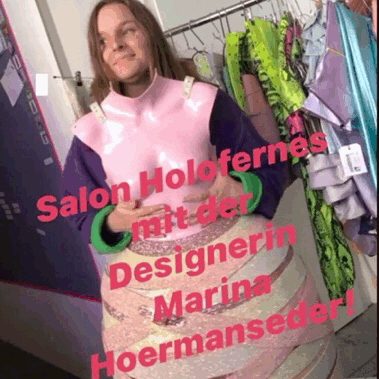
1 note
·
View note
Photo
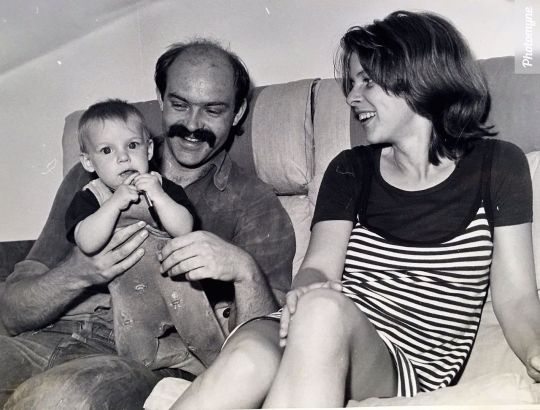

Judith Holofernes & her parents then and now.
Judith also recorded an episode of her podcast “Salon Holofernes” with her mother who is a translator.
1 note
·
View note
Photo

2 notes
·
View notes